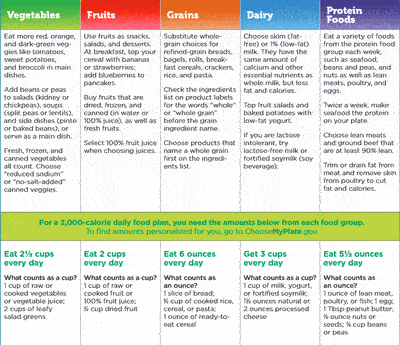MyPlate: What a Healthy Meal Looks Like
Author: Cornell Food and Brand Lab
Published: 2013/12/29 - Updated: 2022/01/14
Category Topic: Nutrition and Healthy Food - Academic Publications
Page Content: Synopsis - Introduction - Main
Synopsis: MyPlate was created in 2011 by the United States Department of Agriculture (USDA) to help American consumers put the Dietary Guidelines into practice. Most Americans know about MyPyramid - the triangle depicting how many servings of each food group you should eat in a day - but who knows about MyPlate - the circle showing what a healthy meal looks like?
Introduction
Food preferences, cooking ability, involvement of children in food preparation, nutritional knowledge, and prior familiarity with MyPyramid were predictors of MyPlate awareness and use.
Main Content
Most Americans know about MyPyramid - the triangle depicting how many servings of each food group you should eat in a day - but who knows about MyPlate - the circle showing what a healthy meal looks like?
The current nutrition guide published by the United States Department of Agriculture, depicting a place setting with a plate and glass divided into five food groups. It replaced the USDA's MyPyramid guide. MyPlate is divided into sections of approximately 30 percent grains, 30 percent vegetables, 20 percent fruits and 20 percent protein, accompanied by a smaller circle representing dairy, such as a glass of low-fat/nonfat milk or a yogurt cup. MyPlate will be displayed on food packaging and used in nutrition education in the United States.
MyPlate was created in 2011 by the United States Department of Agriculture (USDA) to help American consumers put the Dietary Guidelines into practice. It's a simple, colorful icon that prompts us to think about what's on our plate, illustrating healthy proportions of fruit, vegetables, grains, protein, and dairy within a single meal.
Dr. Brian Wansink of Cornell University and Dr. Sibylle Kranz of Purdue University wanted to find out who "got the memo" about MyPlate first - that is, who became familiar with MyPlate within 3 months of its release. In particular, the researchers were interested in mothers, who play the role of "nutritional gatekeeper" in most families, and what traits these trend-setting mothers had in common with each other. A national on-line survey was completed by 497 moms, ranging in age from 18 to 65, including questions about their demographics, knowledge, attitudes, and behavior.

MyPlate - Consumer Messages
Of these:
- 497 moms, 46 moms were familiar with MyPlate (9% of those surveyed)
- 105 were somewhat familiar (21%),
- 349 were not familiar (70%).
Some Interesting Patterns Emerged
- First, moms were more likely to be familiar with MyPlate if they already knew about MyPyramid.
- Second, moms who found MyPlate easy to understand and relevant to their lives were more likely to see its potential to help their families eat better.
- Third, moms who adopted MyPlate were more likely to be "vegetable lovers" and to involve their kids in preparing family meals. Moms loved veggies for a variety of reasons - not only because they are good for you, but also because they can improve the taste of the entrees they're served with and make meals feel like special family occasions.
So, what can the rest of us learn from these trend-setting MyPlate moms?

Recommendations
- Involve kids in meal preparation. This doesn't just mean cooking - kids can also make grocery lists, clip coupons, and set and clear the table.
- Don't just tell your kids to eat their veggies - show them that you do too. Make it a family priority to try new vegetables or new recipes for familiar ones. Who knows, you may become a vegetable lover!
- Log onto to https://www.myplate.gov Like the MyPlate icon, this website is colorful and user-friendly. It features practical tips for meal planning, grocery shopping, and preparing simple, tasty meals for a range of budgets and taste buds.
For Americans who eat out or on-the-go, there are strategies for keeping MyPlate in mind while navigating restaurant menus. Find out what the USDA can do for you and your family!
Attribution/Source(s): This quality-reviewed publication was selected for publishing by the editors of Disabled World (DW) due to its relevance to the disability community. Originally authored by Cornell Food and Brand Lab and published on 2013/12/29, this content may have been edited for style, clarity, or brevity.